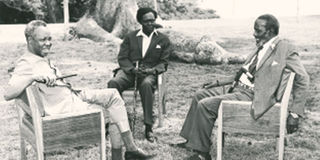Leaders launch economic bloc

East Africa’s founding presidents (from left) Julius Nyerere (Tanzania), Milton Obote (Uganda) and Jomo Kenyatta (Kenya). The three agreed to form the EAC in Arusha in 1967. PHOTO/FILE
What you need to know:
- Key institutions that employed many citizens of the three countries included the East African Railways and Harbours, East African Airways, East African Posts and Telecommunications and East African Development Bank.
The East African Community (EAC) currently prides itself as the most progressive of all the five regional economic blocks in Africa.
But the current success did not come easy, mainly due to lingering struggles between the pro-regional co-operation forces and those who wanted individual countries to chart their own course.
Britain had wanted to create a federation of the three East African states, but the idea was fiercely opposed by the Baganda in Uganda.
Mwalimu Julius Nyerere, a strong supporter of the cooperation, was even willing to delay the independence of Tanganyika in 1961 so that the region could attain independence as one federation.
The British first established the customs union between Kenya and Uganda in 1917, while the then Tanganyika joined in 1927. This co-operation was upgraded to the East African High Commission from 1948 to 1961.
This provided a customs union, a common external tariff, currency and postage, and also dealt with common services in transport and communications, research and education.
So, when the three countries became independent in succession beginning 1961 (Tanganyika), 1962 (Uganda) and Kenya in 1963, there was greater need for them to co-operate on the economic front.
Independence leaders were in agreement when the British established the East African Common Services Organisation from 1961 to 1967.
The community was launched in 1967 in Arusha to strengthen the ties between the three member states through a common market, a common customs and tariff and a range of public services like railways, airways, ports and harbours so as to achieve balanced economic growth within the region.
Besides offering a large market for foreign direct investment with many multinationals establishing themselves in the region, the community established corporations that cut across borders and citizens of the community moved and worked across the region, from professionals to the casual labourers.
Key institutions that employed many citizens of the three countries included the East African Railways and Harbours, East African Airways, East African Posts and Telecommunications and East African Development Bank.
The community operated well in the initial stages, because the leaders then —Jomo Kenyatta, Nyerere and Dr Apollo Milton Obote — were still learning the ropes of leadership and regional geopolitics.
Soon, problems started creeping in, mainly due to the fact that the organisation was politically-driven and some of its key decisions depended on the whims of the leaders at that time.
Later, ideological differences became clear with Kenya embracing capitalism, Tanzania opting for socialism in the form of Ujamaa, while Uganda was oscillating between capitalism and socialism through Obote’s political and economic blueprint — The Common Man’s Charter.
Idi Amin’s ascendency to power in Uganda through a military coup in 1971 further heightened the political differences.
But historians believe that the actual collapse of the community after 10 years was due to the different levels of economic development, where Kenya took most of the benefits and the other partner states were merely net importers from Kenya.
The powerful elite in the Kenyatta government, such as former Attorney-General, Charles Njonjo, had no time for the community.
Finally, the bloc collapsed in 1977, with the three countries descending into bitter scramble for its property.
To date, a section of Tanzanians are yet to overcome their suspicions of Kenyans for having grabbed most of the properties.
That “suspicion” is one of the reasons why Tanzania is reluctant to implement certain aspects of the common market in the revived EAC, and has particularly rejected making land part of the shared resources.
The EAC was revived in 1999, and now includes Rwanda and Burundi in its fold.




